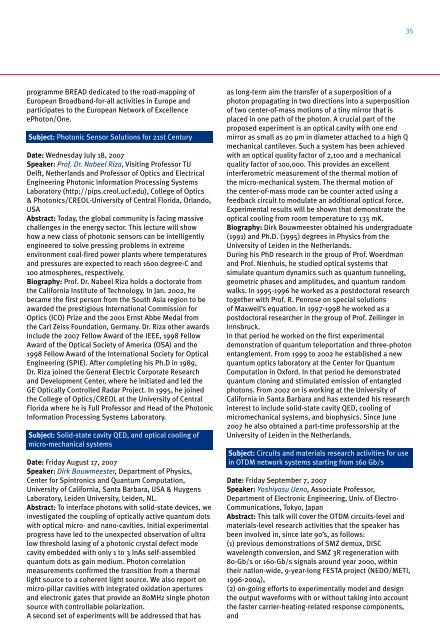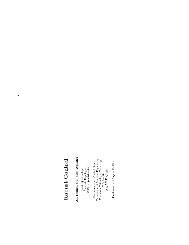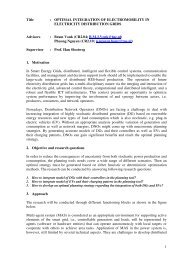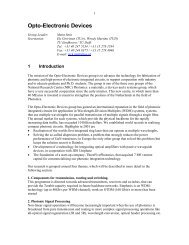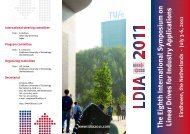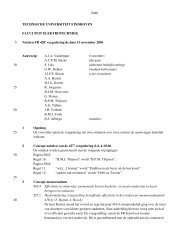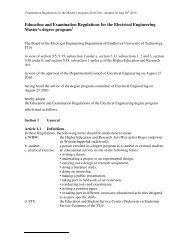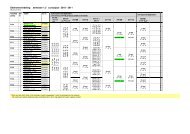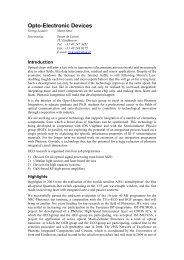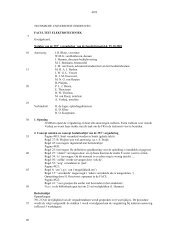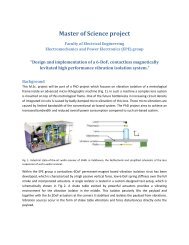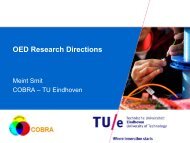COBRA Annual Report 2007 - Technische Universiteit Eindhoven
COBRA Annual Report 2007 - Technische Universiteit Eindhoven
COBRA Annual Report 2007 - Technische Universiteit Eindhoven
Create successful ePaper yourself
Turn your PDF publications into a flip-book with our unique Google optimized e-Paper software.
programme BREAD dedicated to the road-mapping of<br />
European Broadband-for-all activities in Europe and<br />
participates to the European Network of Excellence<br />
ePhoton/One.<br />
Subject: Photonic Sensor Solutions for 21st Century<br />
Date: Wednesday July 18, <strong>2007</strong><br />
Speaker: Prof. Dr. Nabeel Riza, Visiting Professor TU<br />
Delft, Netherlands and Professor of Optics and Electrical<br />
Engineering Photonic Information Processing Systems<br />
Laboratory (http://pips.creol.ucf.edu), College of Optics<br />
& Photonics/CREOL-University of Central Florida, Orlando,<br />
USA<br />
Abstract: Today, the global community is facing massive<br />
challenges in the energy sector. This lecture will show<br />
how a new class of photonic sensors can be intelligently<br />
engineered to solve pressing problems in extreme<br />
environment coal-fired power plants where temperatures<br />
and pressures are expected to reach 1600 degree-C and<br />
100 atmospheres, respectively.<br />
Biography: Prof. Dr. Nabeel Riza holds a doctorate from<br />
the California Institute of Technology. In Jan. 2002, he<br />
became the first person from the South Asia region to be<br />
awarded the prestigious International Commission for<br />
Optics (ICO) Prize and the 2001 Ernst Abbe Medal from<br />
the Carl Zeiss Foundation, Germany. Dr. Riza other awards<br />
include the <strong>2007</strong> Fellow Award of the IEEE, 1998 Fellow<br />
Award of the Optical Society of America (OSA) and the<br />
1998 Fellow Award of the International Society for Optical<br />
Engineering (SPIE). After completing his Ph.D in 1989,<br />
Dr. Riza joined the General Electric Corporate Research<br />
and Development Center, where he initiated and led the<br />
GE Optically Controlled Radar Project. In 1995, he joined<br />
the College of Optics/CREOL at the University of Central<br />
Florida where he is Full Professor and Head of the Photonic<br />
Information Processing Systems Laboratory.<br />
Subject: Solid-state cavity QED, and optical cooling of<br />
micro-mechanical systems<br />
Date: Friday August 17, <strong>2007</strong><br />
Speaker: Dirk Bouwmeester, Department of Physics,<br />
Center for Spintronics and Quantum Computation,<br />
University of California, Santa Barbara, USA & Huygens<br />
Laboratory, Leiden University, Leiden, NL.<br />
Abstract: To interface photons with solid-state devices, we<br />
investigated the coupling of optically active quantum dots<br />
with optical micro- and nano-cavities. Initial experimental<br />
progress have led to the unexpected observation of ultra<br />
low threshold lasing of a photonic crystal defect mode<br />
cavity embedded with only 1 to 3 InAs self-assembled<br />
quantum dots as gain medium. Photon correlation<br />
measurements confirmed the transition from a thermal<br />
light source to a coherent light source. We also report on<br />
micro-pillar cavities with integrated oxidation apertures<br />
and electronic gates that provide an 80MHz single photon<br />
source with controllable polarization.<br />
A second set of experiments will be addressed that has<br />
35<br />
as long-term aim the transfer of a superposition of a<br />
photon propagating in two directions into a superposition<br />
of two center-of-mass motions of a tiny mirror that is<br />
placed in one path of the photon. A crucial part of the<br />
proposed experiment is an optical cavity with one end<br />
mirror as small as 20 μm in diameter attached to a high Q<br />
mechanical cantilever. Such a system has been achieved<br />
with an optical quality factor of 2,100 and a mechanical<br />
quality factor of 100,000. This provides an excellent<br />
interferometric measurement of the thermal motion of<br />
the micro-mechanical system. The thermal motion of<br />
the center-of-mass mode can be counter acted using a<br />
feedback circuit to modulate an additional optical force.<br />
Experimental results will be shown that demonstrate the<br />
optical cooling from room temperature to 135 mK.<br />
Biography: Dirk Bouwmeester obtained his undergraduate<br />
(1991) and Ph.D. (1995) degrees in Physics from the<br />
University of Leiden in the Netherlands.<br />
During his PhD research in the group of Prof. Woerdman<br />
and Prof. Nienhuis, he studied optical systems that<br />
simulate quantum dynamics such as quantum tunneling,<br />
geometric phases and amplitudes, and quantum random<br />
walks. In 1995-1996 he worked as a postdoctoral research<br />
together with Prof. R. Penrose on special solutions<br />
of Maxwell’s equation. In 1997-1998 he worked as a<br />
postdoctoral researcher in the group of Prof. Zeilinger in<br />
Innsbruck.<br />
In that period he worked on the first experimental<br />
demonstration of quantum teleportation and three-photon<br />
entanglement. From 1999 to 2002 he established a new<br />
quantum optics laboratory at the Center for Quantum<br />
Computation in Oxford. In that period he demonstrated<br />
quantum cloning and stimulated emission of entangled<br />
photons. From 2002 on is working at the University of<br />
California in Santa Barbara and has extended his research<br />
interest to include solid-state cavity QED, cooling of<br />
micromechanical systems, and biophysics. Since June<br />
<strong>2007</strong> he also obtained a part-time professorship at the<br />
University of Leiden in the Netherlands.<br />
Subject: Circuits and materials research activities for use<br />
in OTDM network systems starting from 160 Gb/s<br />
Date: Friday September 7, <strong>2007</strong><br />
Speaker: Yoshiyasu Ueno, Associate Professor,<br />
Department of Electronic Engineering, Univ. of Electro-<br />
Communications, Tokyo, Japan<br />
Abstract: This talk will cover the OTDM circuits-level and<br />
materials-level research activities that the speaker has<br />
been involved in, since late 90’s, as follows:<br />
(1) previous demonstrations of SMZ demux, DISC<br />
wavelength conversion, and SMZ 3R regeneration with<br />
80-Gb/s or 160-Gb/s signals around year 2000, within<br />
their nation-wide, 9-year-long FESTA project (NEDO/METI,<br />
1996-2004),<br />
(2) on-going efforts to experimentally model and design<br />
the output waveforms with or without taking into account<br />
the faster carrier-heating-related response components,<br />
and


